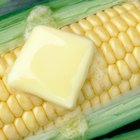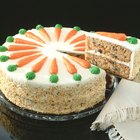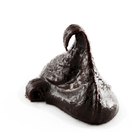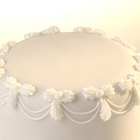
Most baked goods require some type of fat in the form of butter, oil or solid shortening to give them structure, volume and moisture. How the batter or dough is prepared determines in part the type of fat needed, and substitutions can be made in some cases. Generally speaking, cakes made from mixes call for a wet pourable fat such as vegetable or cooking oil, and melted butter or margarine can be substituted without adversely affecting taste or texture.
Cake Mix Basics
Cakes mixes contain all the necessary dry ingredients, including flour, sweeteners and leaveners, and need only the addition of wet ingredients in the form of eggs, water and oil to create a smooth lump-free batter. Eggs bind the ingredients together, while water supplies moisture and oil enhances the texture of the finished cake. The amount of oil called for also supplements the small amount of fat in the form of soybean and vegetable oils already present in the mix.
The Right Ratio
As a liquid, pourable fat when melted, margarine can be substituted for vegetable or cooking oil in a cake mix using a 1-to-1 ratio, which means that you should use the same amount of melted margarine as the amount of oil called for in the baking directions. You can melt the margarine in a microwave-safe bowl, which takes about 20 seconds, or in a small pan on the stove placed over low heat, which takes a little longer. Allow the margarine to cool slightly before adding it to the cake mix, as you don't want to "cook" the dry ingredients or the eggs.
Choosing the Right Margarine
Not all margarine is the same, so be sure to use real margarine and not a spread in your cake mix. Like butter, real margarine is 80 per cent fat in the form of oil, and 20 per cent water and solids that include salt. It melts the same as butter and if allowed to harden after melting, the fat solids tend to separate from the liquids the same as they do in butter. Buttery spreads contain significantly less fat and more water along with other ingredients, and some spreads can be composed of as much as 40 per cent water, which makes them unsuitable for use in cake mixes. The lower fat content in margarine spreads also affects baked goods by making them drier and tougher, and interferes with rising.
A Few More Specifics
There is no particular order in which to combine the cake mix ingredients with the eggs, water and melted margarine, as they all go into the bowl all at once. A standard mix for yellow cake instructs you to blend the mix on low speed until all the dry ingredients are moistened, which takes about 30 seconds. Then increase the mixer speed to medium and beat the batter for 2 more minutes or until it's smooth and creamy. Because melted margarine will go back to its solid state if allowed to sit too long at room temperature, be sure to mix all the ingredients immediately.
Related Articles

What Can You Substitute for Oil While ...

Cake Emulsifier Substitute

Adding Cold Water to Whipped Butter

How to Substitute Oleo for Cooking Oil ...

Common Food Emulsifiers

How to Bake a Really Moist Boxed Cake

How to Use Shortening Instead of Oil ...

What Kind of Oil Do You Use in Brownie ...

What Are Good Substitutes for Vegetable ...

Can I Substitute Coconut Milk for ...

Does Whipped Butter Have to Be ...

How to Bake a Cake Without Egg Whites

Making Chocolate From Cocoa Powder

How to Make a White Decorator Icing

Difference Between American and ...

Calories in Peppermint Extract

Nutrition in Carob Vs. Chocolate

What Is 916 in Jewelry?

What Is a Substitute for Potassium ...

The Ingredients in Jergens Naturals
References
Writer Bio
Rachel Lovejoy has been writing professionally since 1990 and currently writes a weekly column entitled "From the Urban Wilderness" for the Journal Tribune in Biddeford, Maine, as well as short novellas for Amazon Kindle. Lovejoy graduated from the University of Southern Maine in 1996 with a Bachelor of Arts in English.
Photo Credits
Jupiterimages/Stockbyte/Getty Images